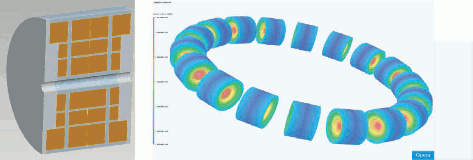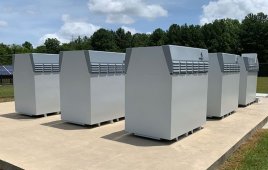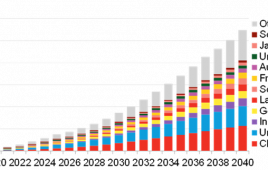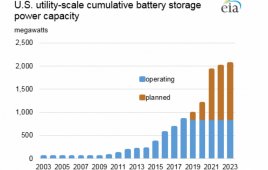There is more than one way to store a watt. For instance, about seven years ago, the DOE-funded development of a project titled “Superconducting Magnet Energy Storage System with Direct Power Electronics Interface.” The $5.25 million effort was to develop an affordable system capable of large-scale energy storage that would be a game-changing advance for the U.S. electrical grid.
In a cryogenic environment, near absolute zero, even copper is superconducting. A coil of it charges just like a battery or capacitor. “What’s more, energy can be stored in a superconducting coil for a long period. And when the power is needed, connecting a load across the coil taps the power,” he says.

SMES coil blocks (brown) inside a (gray) mechanical structure. Several of the coils arranged as they are to the right would provide the superconducting storage.
Material researchers are now working on materials that superconduct at relatively high-temperature, around 77°K, (-372°F), the temperature of liquid nitrogen. A superconducting cable made with such a material can be smaller than conventional cable yet carry a large current. For instance, the AMSC website says its superconducting cable made with its Amperium can carry 10 times more power than conventional cables.
The initial group proposed an ultra-high-field SMES-based storage that would bring down storage costs to a point where they would be comparable in cost per kilowatt-hour to conventional storage systems. Scaling would be easy if the superconducting materials were available. Unfortunately, developing ultra-high-field SMES systems presented greater technical challenges than expected. The project came up short and was ended when the funding ran out.
However, energy storage remains one way to make renewable energy more useful. Superconducting Magnet Energy Storage (SMES) systems use magnetic fields in superconducting coils to store energy with near-zero energy loss, have an instantaneous dynamic response, and nearly infinite cycle life.
SuperPower Inc, one of two U.S. manufacturers for high-temperature superconducting materials was to develop next-generation HTS wires. These would be a key component to a cost-effective grid-scale SMES system that would offer megawatt hours of stored energy and thereby support a growing infrastructure for renewable energy.
SMES is already proven to work, says Dr. Syed Ahmed, Executive Director with the Advanced Superconductor Manufacturing Institute at the University of Houston’s Division of Research. Commercially available and relatively small SMES units are often used as short-term power devices designed to compensate for fluctuations in an electrical power system. By about 2002, AMSC came up with the D-Var, a superconducting device for wind-farm grids. It works as energy storage when connected to the grid. “When it senses a voltage drop, the device discharges into the line to maintain the voltage. They have been used on the long transmission lines in the Midwest,” added Ahmed. “It is a good example of superconducting magnetic-energy storage. It works. However, making them into a grid-scale energy storage solution is a completely new ballgame.”
Ahmed had worked on superconducting magnetic storage at an earlier position. “It was a small 10-kilowatt scale version for aerospace applications. The attractive feature of superconducting wire is that has no resistance, so once it is charged the current keeps on circulating and does not dissipate.” But scaling such a device from kilowatts to megawatts, however, calls for more superconducting wire.
A lot of research in superconducting manufacturing is underway. Over 35 companies are members of Advanced Superconductor Manufacturing Institute (ASMI). Although projects are expensive, Ahmed says they are worth it. “Such power storage could be a $220 billion market and if it is not developed here, it will be imported. In 2006 there were only two companies making superconducting wire, but at this time there are 12 in the world including China, Russia, Germany, and more getting interested in tapping this upcoming market. Millions of dollars are being invested by other governments that see SMES as a huge potential. We are a leader but cannot maintain our leadership without proper support,” cautions Ahmed.
Filed Under: Energy storage




